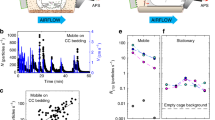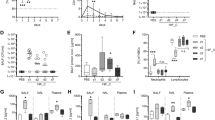Abstract
WE studied the dynamics of the infection with influenza virus in mice after intra-nasal administration of extremely low doses. White mice were infected with the mouse-adapted Em2 strain of the A1 type influenza virus. The virus, used in the form of infected allantoic fluid, showed LD50 titres of 105.1 and 105.45 0.1 ml., respectively, as estimated by intra-nasal inoculation of white mice, and a TCID50 titre of 104.88 and 105.52 0.1 ml., respectively, as determined in suspended chlorio-allantoic membrane tissue cultures1—herein designated as Horváth's TC. Mice weighing 16–18 gm. were inoculated under light ether anaesthesia intra-nasally in individual experiments (altogether 6 experiments in 3 independent series) with 0.05 ml. of infected allantoic fluid, containing 10−2.12–100.88 TCID50 0.1 ml.; in other words, in each case with a lower dose than 1 mouse LD50. Starting with the first day after inoculation, 3 mice were killed daily and from their lungs 10 per cent suspensions in Horváth's1 nutrient medium were prepared. The suspensions were clarified by centrifugation at 2,500 r.p.m. for 10 min. and serial 10-fold dilutions of them inoculated into Horváth's TC. The cultures were incubated at 35° C. for 72 hr. and the reproduced virus detected by hæmagglutination test on plastic plates2. The results are shown in Fig. 1. It can be seen that the multiplication of the virus in the lungs depends on the dose of the virus administered and shows a cyclic character. After administration of the lowest dose (0.0038 TCID50 in 0.05 ml.), virus was first detected three days after infection. It is still present on the fourth day, but thereafter disappears and is not detectable up to day 12. After administration of a 10-times higher dose the virus appears in the lung also on day 3, it is not detectable for the next five days and appears repeatedly on day 9 or 10 after infection. The higher the dose administered, the shorter the time intervals of the cyclic appearance and disappearance of virus in the lungs. After infection with 2.6 TCID50 and 3.8 TCID50 in 0.05 ml., respectively, a complete disappearance of virus from lungs was not detected during the whole observation period, although even in these cases an appreciable variation in infectivity titres was seen. It is to be noted that the first disappearance of virus and/or a marked lowering of its titre occurred in all experiments 4–5 days after infection. Virus-neutralizing antibodies were not detected in sera of mice for 10–14 days after infection.
This is a preview of subscription content, access via your institution
Access options
Subscribe to this journal
Receive 51 print issues and online access
$199.00 per year
only $3.90 per issue
Buy this article
- Purchase on Springer Link
- Instant access to full article PDF
Prices may be subject to local taxes which are calculated during checkout
Similar content being viewed by others
References
Horváth, I., Acta Microbiol. Hung., 1, 481 (1954).
Takátsy, Gy., Acta Microbiol. Hung., 3, 191 (1955).
Isaacs, A., and Lindenmann, J., Proc. Roy. Soc., B, 147, 258 (1957).
Isaacs, A., and Hitchcock, G., Lancet, ii, 69 (1960).
Wanger, R. R., Bact. Revs., 24, (1960).
Author information
Authors and Affiliations
Rights and permissions
About this article
Cite this article
LINK, F., RAUS, J. Multiplication of Mouse-adapted Influenza Virus in Mouse Lungs after Infection with Very Low Doses. Nature 192, 478–479 (1961). https://doi.org/10.1038/192478a0
Issue Date:
DOI: https://doi.org/10.1038/192478a0
This article is cited by
Comments
By submitting a comment you agree to abide by our Terms and Community Guidelines. If you find something abusive or that does not comply with our terms or guidelines please flag it as inappropriate.



